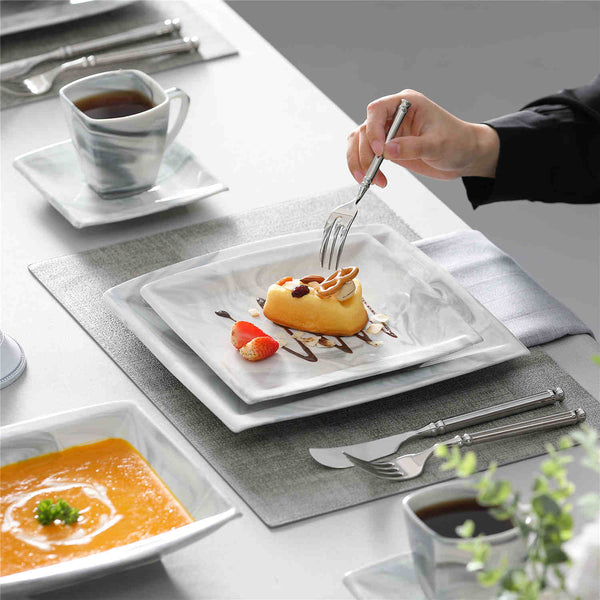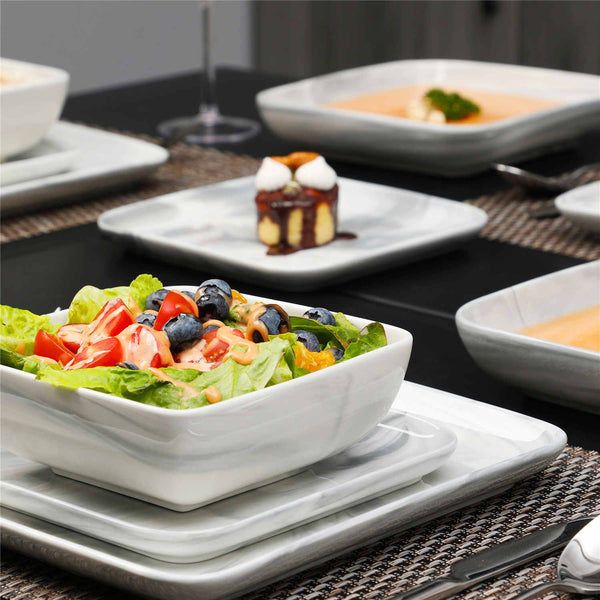How to Heat Food in the Oven Without Damaging Your Dinnerware?
Navigation
Thermal shock is a common issue that can severely impact the dinnerware, especially the pieces made of ceramic such as porcelain and stoneware. Thermal shock occurs when there is a sudden change in temperature level. The sudden changes in the temperature cause the material to expand or contract rapidly. It leads to increased stress that further causes cracks or breakage. It can also happen when the hot dinnerware pieces are immediately exposed to cold surfaces or cold water.
It is quite crucial to ensure proper preventive measures to avoid thermal shock. You must preserve the integrity of your dinnerware. You must allow the dinnerware to cool down gradually. There must be no sudden change in temperature. You must ensure proper handling and care practices. It is crucial to understand and implement these techniques as they will help you ensure that your dinnerware remains elegant and functional for many years to come.
Understanding the means to avoid thermal shock
By carefully following these preventive techniques, you can ensure that your dinnerware remains intact for a long time.
Start with a cool oven
To ensure the integrity of your dinnerware, you must avoid thermal shock. It is a good practice to start with a cool oven. This means you must place cool dinnerware in a cool oven. And of course, you must have oven-safe dinnerware in the very first place. After placing the cool dinnerware in the cool oven, gradually increase the temperature level.
When you start with room temperature or slightly warmed dinnerware, it can help you to successfully avoid sudden temperature changes that can lead to different cracks or breakage.
Heat the food gradually
The gradual heating process is also crucial to ensure the integrity of the dinnerware. Ceramic is sensitive to rapid temperature changes which can lead to thermal shock causing undesirable circumstances.
When warming dinnerware in the oven, it is significant to do so slowly. Ensure to begin with a low temperature such as 225°F and gradually increase the temperature as per requirement. This gradual increase in temperature level allows the dinnerware to adjust the changes more easily, minimizing the risk of thermal shock.
It is important to be patient and avoid rushing the heating process. Take proper time to warm your dinnerware slowly. It will help you ensure that the dinnerware pieces will retain their beauty and functionality.
Avoid wet surfaces
To further prevent the thermal shock and protect your dinnerware, avoid placing hot dishes on wet surfaces or refrain from handling them with wet clothes. Exposure to wet surfaces can cause rapid cooling of the dinnerware that can increases the chances of thermal shock. With this rapid cooling, the pieces are at greater risk of breaking or cracking.
Instead, ensure that the surface is dry before placing the dinnerware on it. Use dry cloth or potholder to handle hot dinnerware pieces. Ensure that there must be no moisture coming from the contact with hot surface.
Take heat precautions and handle properly
To protect your dinnerware, it is important to follow proper handling techniques and practices, especially when it comes to exposure to direct heat.
Avoid direct heat sources: Dinnerware sets made up of ceramic-like porcelain should never be placed directly on heat sources such as stoves or open flames, etc. It can create uneven heating that further increases the risk of thermal shock.
Use potholders or oven mitts: While handling hot dinnerware, always use oven mitts or potholders. It will not only help you protect your hands but also minimize the risk of accidental drops.
Allow for proper cooling time: Allow the dinnerware to cool down properly after removing it from the oven or microwave. You must not place the hot dinnerware on countertop or table. Always remember that placing hot dinnerware on cool surfaces can cause thermal shock.
Avoid extreme temperature changes: As discussed earlier, you must not expose dinnerware to extreme temperature changes. You must not place hot dinnerware in cold water or cold dinnerware in a hot oven. Ensure gradual temperature changes as they are less likely to cause damages.
Use dishwasher and microwave safe dinnerware: If you want to use your dinnerware in dishwasher and microwave, make sure it is labelled as microwave and dishwasher safe. Your dinnerware pieces must be safe for such uses. Not all dinnerware sets can survive the heat and moisture of these machines. Read the labels at the back of the pieces to understand the nature of your chosen dinnerware set.
These are some precautionary measures that can help you protect your dinnerware from thermal shock. Ensure that your dinnerware set remains in good condition for a long time and keeps beautifying your dining space.
Special considerations for different materials
It is important to remember that the earthenware can get extremely hot especially when it is used in microwaves or ovens. It calls for more careful handling. Ensure that you use oven mitts or potholders to prevent any kinds of burns. Nothing is more important than ensuring safe usage.
Moreover, porcelain dinnerware sets that include metallic rims must never be used in the ovens. Metallic rims are at higher risk to cause sparks. They can also cause damage to the microwave, leading to severe safety hazards. Never forget to check the manufacturer's guidelines to understand the safety instructions properly.
You must ensure the integrity and longevity of your dinnerware. Always start with a cool dinnerware in a cool oven. It is a very significant step to avoid any sudden change in temperature level. Increase the temperature level at a gradual pace. Start with a low temperature like 225°F. Don’t expose the dinnerware to rapid temperature changes. Never place a hot dinnerware on a cold surface or a cold dinnerware in hot water.
Select the appropriate dinnerware by carefully analyzing the type of food you are serving. The selection of your dinnerware must not only be aligned with the type of cuisine you are serving but also suit the cooking method being used to avoid any form of damage or accident.
Be aware of special considerations of different types of dinnerware materials and their particular precautionary practices. For example, you must carefully handle the earthenware as it can get extremely hot in oven and you must also avoid placing porcelain with metallic rims in the oven as it can cause sparks.
Remember, your ultimate goal is to let your guests enjoy hot meals while successfully preserving and retaining the beauty of your dinnerware for many years to come. A properly handled and maintained dinnerware can help the diners enjoy the overall vibe of the evening to a great extent. When hot meal is served in elegant-looking dinnerware pieces, it automatically instigates the appetite of the diners.
You must ensure the smooth transition of your well-cooked meal from the microwave to the dining table. We wish you a happy and safe dining!









Leave a comment